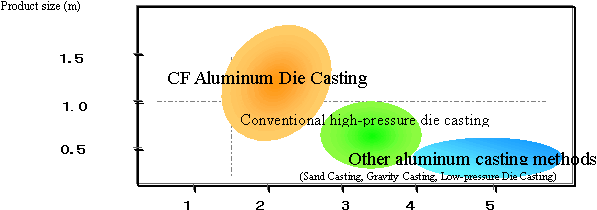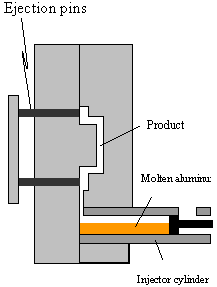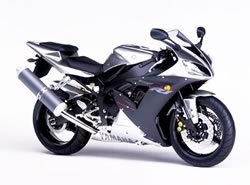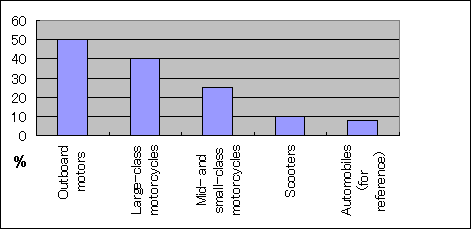Yamaha Motor Co., Ltd. (YMC) has succeeded in the development of a new manufacturing technology called the “Yamaha CF Aluminum Die Casting Technology”* that enables the mass production of large but thin aluminum die-cast parts in an environment-friendly, low-cost way that will contribute significantly to manufacturing innovation.
* CF Die Casting = Controlled Filling Die Casting
Aluminum die casting is a technology that brings excellent manufacturing productivity to aluminum parts, with their inherent qualities of light weight, rust resistance and recyclables. As a result, die-cast aluminum parts are used in large numbers in motorcycle engines and chassis as well as outboard motors. However, with conventional die casting there has always been a limit to the thinness of sections in a cast piece in relationship to its overall size. That is why it has long been difficult in the industry to produce die-cast parts that are both large overall and thin in some sections.
Furthermore, with the present trend toward environmental concerns resulting in the shift to 4-stroke engines and the addition of exhaust-cleaning devices which increase both the weight and number of parts for future models, it is believed that the keys to manufacturing innovation will be lightening technologies in combination with measures that reduce cost and improve fuel efficiency.
The newly developed “Yamaha CF Aluminum Die Casting Technology” is a process that enables mass production of aluminum die-cast parts that are both large and thin in sections, thus making it a technology that answers today’s social needs by enabling the production of lighter products with fewer parts. Focusing on improving the flow characteristics of the molten aluminum as it is poured into the metallic mold (die), Yamaha’s new technology greatly improves the smoothness of the flow into the die by (1) increasing the vacuum inside the die, (2) regulating the temperature of the die and (3) improving the injection speed of the molten aluminum. The combined effects of these measures enable the mass production of high-quality die-cast aluminum parts with an air-intrusion rate (cause of air bubbles) of about one-fifth that of conventional die casting.
The introduction of this new technology to the manufacturing process can result in about a 30% reduction in part weight and 80% reduction in the number of parts necessary. Furthermore, the reduction in the amount of aluminum used and the simplification of the manufacturing process will bring an estimated 30% reduction in cost compared to the conventional die casting method. And, because it does not require specialized aluminum alloys, this technology can be readily transferred to overseas manufacturing bases on the condition that the metallic molds be changed as well.
At Yamaha we will apply of this technology to a wide range of products such as motorcycles and outboard motors. |
Comparison of CF Aluminum Die Casting and other conventional die-cast methods |

|
Minimum piece thickness(mm) |
 |
 |
Summary of the Technology |
 |
 |
Due to the controlled conditions under which the molten aluminum is injected into the metallic mold (die) at high speeds and high pressure in conventional high-pressure die casting, a certain amount of air and oxides inevitably enter along with the aluminum, resulting in generating air bubbles in the final cast metal. As a result, there was a limit to how thin sections of the cast parts could be and how sharp the curves in the parts could be. This was a weakness of the conventional die casting method that left room for improvement. The “Yamaha CF Aluminum Die Casting Technology” is the result of development efforts focused on the “shaping technology” applied to aluminum die-cast parts in order to improve on this weakness.
The technical focus in developing this new method was to optimize the flow characteristics of the molten aluminum to obtain the best possible flow into the die in the short time before the aluminum begins to solidify, with optimum evenness in the final lie of the aluminum before it hardens.
To achieve this, we built on the technological base acquired from our long years of experience in vacuum aluminum die casting and added an exclusive new method for improving the completeness of the vacuum in the die which also made possible more precise control of the various aspects of the casting process. Specifically speaking, we optimized the conditions of the molten aluminum injection into the die by (1) introducing an exclusively developed new type of seal material for sealing the die parts together to increase the completeness of the vacuum inside the mold and reduce the air resistance (six fold improvement over conventional method), (2) controlling the temperature of the mold in order to achieve a more stable temperature in the molten aluminum and, (3) increasing the speed of the molten aluminum injection (five times over conventional method). The combined effect of these measures reduced the amount of air (gases) in the resulting cast metal to one-fifth the amount of the conventional method. This results in a stronger quality aluminum that, unlike conventional die-cast aluminum, is strong enough to be welded, which in turn makes possible the mass production of aluminum die-cast parts that are both large and thin in relevant sections.
This new method makes it possible to manufacture aluminum parts with the high efficiency of high-pressure die casting, and with strength and stretchability equal to gravity casting. Also, this has made it possible to produce the kind of large but thin aluminum die-cast parts that were difficult under the conventional die casting methods. Furthermore, since this new method enables the mass production of cast aluminum parts designed for extreme thinness and more complex curves, it will suggest new design standards for cast aluminum parts. |
Conventional Aluminum
Die casting Technology

|
Yamaha CF Aluminum Die Casting Technology
Characterized by (1) seals inserted between mold sections to increase vacuum completeness,
(2) stabilization of the molten aluminum temperature by controlling mold temperature,
(3) improved injection speed for the molten aluminum. |
|
|
 |
 |
Reference
|
 |
 |
 |
Development Background |
|
Amid the increasing concern for environmental preservation, there has been a rapid shift toward 4-stroke engines for motorcycles and outboard motors, as well as the adoption of emissions-reducing catalyzers and electronic fuel injection systems. There has also been an increasing movement toward hybrid vehicles, all of which has resulted in a revolution in vehicle engine and chassis design. Naturally, there is a concern that these additional systems will increase the weight of engines. Accordingly, the key is to use lightweight aluminum and lightweight design technologies to cancel out this added weight so that products can maintain past performance levels or even improve on them.
Aluminum is about 34% lighter than steel and is also excellent for casting thanks to its low melting point and good flow characteristics. Aluminum is also easier to reuse than other metals and there is almost no difference in the quality of the metal produced from recycled aluminum compared to new stock. Also, by combining it with other metals and selecting different kinds of thermo physical methods, it can be made to fit the needs of different uses. Taking advantage of these beneficial qualities, Yamaha uses aluminum in many of its products.
Particularly in products like motorcycles, snowmobiles and personal watercraft with which customers enjoy the handling and the feeling of “man-machine” unity that results, we at Yamaha consider “reducing weight” to be an important part of our manufacturing innovation process. And, one of the ways we reduce weight is by introducing aluminum parts. Presently, the ratio of aluminum (by weight) in our outboard motors is about 50%, while our large-class motorcycles are about 40%. And, as seen by the fact that we use about 3,000 tons of aluminum a month in our factories, improving the quality, the amount, and manufacturing process of aluminum parts has a vital effect on our products from their cost to their quality.
Against this backdrop, Yamaha CF Aluminum Die Casting Technology has developed with the result of our research, development and practice of aluminum die-casting in order to realize our manufacturing innovation. |
 |
 |
This super-sport model “YZF-R1” is 40% aluminum by weight. |
The outboard motor is 50% aluminum by weight.
(Photo:Yamaha F200) |
Aluminum weight ratio for Yamaha products
 |

|